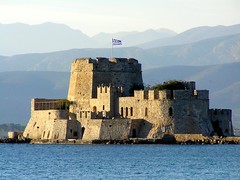Nafplion Travel Guide

Nafplion (Greek: Ναύπλιον) or Nafplio and Anapli (Greek: Ανάπλι) in modern Greek is a town in the Argolic Gulf, in northeast Peloponnese. It has 14,203 inhabitants (as of 2011) and it is the capital of the prefecture of Argolis.
According to the ancient Greek Mythology, the town of Nafplio was founded by Nafplios (or Nauplius), the son of Poseidon and the Danaid Amymone.
Nafplio was the second capital of the State of Independent Greece, during the years 1829–1833, after Aegina (1828–1829). In 1834, Athens was made permanent capital of Greece.
Today, Nafplio is one of the most well-known touristic destinations in Greece, owing to its beauty and glorious history. Thanks to its proximity to Athens, it is an especially popular weekend destination, and its romantic atmosphere makes it one of the preferred places among young couples for romantic breaks.
Places to visit
- the old town of Nafplio, with the narrow pebbled streets and traditional buildings
- the Syntagma Square (=Constitution Square) situated in the centre of Nafplio and surrounded by historical buildings, such as the Old Parliament, the house of Theodoros Kolokotronis (a General and the pre-eminent Leader of the Greek War of Independence), the church of Agios Georgios, the Archaeological Museum and the Mansion of Count Ioannis Kapodistrias (or Giovanni Capo d'Istria), who became the first Governor of Greece in 1827, after the country's independence
- the Arvanitia Promenade, one of the most popular walks in Nafplio, which starts from Arvanitia Square and goes as far as the shore goes, for a total distance of approximately 1 kilometre
- the beach of Karathonas, one of the nicest sandy beaches in the region, as well as the beaches Arvanitia and Neraki
Monuments and Museums to visit
- Bourtzi or Castelli (Fortificazione dello Scoglio di San Teodoro), a very small island in the Argolic Gulf bearing a fortress, which was built around the AD 1470 by the architects Antonio Gambello and Brancaleone by order of the Venetian Francesco Pasqualigo
- the Fortress of Palamidion, built by the Venetian Francesco Morosini during the years 1687–1715, which can be accessed via the road or a stairway of 999 steps
- Akronafplia, which is the acropolis of Nafplio and has held fortifications since the ancient times
- the Archaeological Museum in Syntagma Square housed in a Venetian building constructed in AD 1713
- the National Art Gallery and Alexandros Soutzos Museum, annex of the main museum, which is located in Athens
- the Folklore Museum "Vasileios Papantoniou", founded in 1974, which is one of the best of its kind in the country
- Stathmos, a museum dedicated to children and founded by the Peloponnesian Folk Art Foundation
- the Lion of Bavaria, a statue of a lion, sculpted by the German sculptor Christian Siegel in the years 1840–1841. The erection of the statue was commissioned by Ludwig of Bavaria, father of Otto first King of Greece, to commemorate the Bavarian soldiers that died during the typhoid epidemic in Nafplio (1833–1834), which devastated the region. The model for this sculpture was the famous Lion of Lucerne, by the Danish sculptor Bertel Thorwaldsen
- the Military and War Museum, founded in 1988
- the Automotive Museum Nafplias, featuring historic and classic vehicles of Greek or foreign manufacture
Events to attend
- the Nafplion Festival, which is a music festival that takes place every summer around the end of June and lasts for approximately ten days
- the festivities for the anniversary of Nafplio's liberation from the Turks by Staikos Staikopoulos (November 30, 1822), which take place in November and include among others a footrace called "Palamideios Dromos"
- the festivities taking place during the Christmas period
Food to Drinks to taste
- fresh fish and seafood
- meze nibbles and ouzo at the picturesque taverns of the old town or by the seafront
Map of Nafplion with accommodations
The blue markers shows the location of various accommodations in Nafplion. The letter in the marker describes the accommodation types: H for Hotel, A for Apartment, R for Resort, B for Bed & Breakfast and O for Other (e.g. pension, villa). Click on the blue marker for more information on the accommodation.










